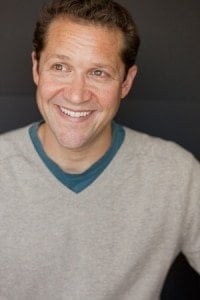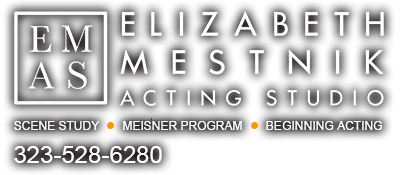Post by Michael Yurchak
Developing characters is a much-debated topic and something that comes up again and again with students, coaches, professionals and newbies. My own approach is one I have found useful, and I am happy to share with you all here! To be sure, there are many ways to skin a cat (sorry cat), so if there are any comments or suggestions, I am more than happy to hear them! For now, though, here’s the way I see it:
1. POV
Assuming you have already handled script analysis and know what kind of project you’re reading for, one of the first things I like to consider when working on a project (either for a gig or an audition) is the character’s point of view (POV). A character’s POV is the way they see the world they live in. It involves status, and shapes the way the character will interact with the other people he or she comes into contact with. It also forms an opinion about the way the character sees things (“Life’s a bowl of cherries!” or “Everything is so unfair!” etc.). This part matters a lot because it will affect the disposition (or mood) of the character. Moods can change, of course, but if the character is a known sour-puss, that may show through even when they’re happy (think Eeyore from Winnie the Pooh).
2. Size and Shape of Character
With POV and status in mind, I start to consider the size and shape of the character. There are different vocal placements one might choose for large characters with high status and a sunny disposition, for example, than one might for a small, high-status character with a chip on his shoulder. A great example of this is the difference between Sully and Randal in the Pixar classic “Monsters Inc.” Both characters are arguably high-status, but their POVs are so vastly different, that even without the superlative vocal stylings of John Goodman and Steve Buscemi, we would hear a clear vocal difference in our heads before giving it a shot ourselves.
Deciding where the voice comes from inside our own bodies and the placement of the voice inside the mouth to derive dialect and tone is sometimes known as “vocal posture” (this is an idea coined by Dudley Knight and Phil Thompson). Kermit the Frog has a guttural placement with a mid- to high-range pitch, for example.
3. Cadence or Rhythm of Speech
This is another important thing to consider. Just as the walk of a physical character will affect the way they are seen by the world, the cadence of a character voice makes a huge difference in how the world takes in the information shared by that character (see Christopher Walken as an example here).
4. Physicality
All of the above will have an impact on how the character moves through space. He or she will have developed a way of moving that works for them (just as we all have). The posture, gate, fluidity, speed, and purpose of motion will be affected by their status and POV. They may also bring a specific animal to mind (remember Jordana’s Rasa workshop?). Getting up and moving with the script, feeling the words come out and how they change with a new posture and movement pattern is an important part of finding the character and adds the last piece of bringing that character to life.
So, now we’re really starting to build something. We’ve considered the character’s POV (including status and disposition). We’ve taken size and shape into consideration, which will affect sound. We’ve played with vocal posture and cadence. Finally, we’ve explored physicality to really put the finishing touches on this guy! During all this pre-work, I always make adjustments to be sure the voice feels comfortable coming out and the body moves as I need it to. I need to be able to breathe, and I have to be able to enunciate clearly (even if the character has a speech impediment, the audience needs to understand the words, unless you are specifically told otherwise). Likewise, I need to be able to move and repeat the movement without causing stress or strain when the gig is finished—no good to twist your body up in a knot if you can’t untie it after the show! In other words, it doesn’t do me any good to create a voice I can only use for a sentence or two or a physical structure that is unsustainable. If I can’t recreate those elements, no matter how cool they look or sound for short bursts, they’re no good to me in the long run (or the folks that want to pay me)!
The Three Cs
The last piece of quality control I always run for myself in terms of delivery is what I call the three Cs: Clarity, Commitment, and Consistency.
Have I made CLEAR choices that are coming from an informed place as far as the character and script are concerned (the “givens” that are learned by reading the script or audition sides carefully)? Am I jumping in with both feet and really COMMITTING to those choices (a sheepish read is not gonna get the job–even if you’re reading for a sheep!)? And, is the character CONSISTENT from beginning to end of the piece, and can I maintain that consistency for the duration of the gig when I get it?
If I can honestly answer yes to these questions, and I like what I hear and see… I go for it and hope for the best, letting it all go as I do and trusting that the work I did in the rehearsal room will be enough to allow me to be present on the actual day without having to effort my vocal and physical moves. Do your best, be proud of the work you create–care about it. If you like what you’re doing, keep working at it. This is an art form. There is no mathematical equation or specific blueprint to solve the question of what a character sounds and looks like. In the end, tell the truth and lead with your heart. Who could ask for anything more?
Thoughts? Comments? Let me hear ’em!
 Michael Yurchak is an award winning actor, voice over artist and educator. In addition to his work with EMAS, Michael works as a Lead Teaching Artist in many theaters throughout the country. Teaching students–of any level–is his genuine passion. To read more about Michael click here, or check out his IMDB page.
Michael Yurchak is an award winning actor, voice over artist and educator. In addition to his work with EMAS, Michael works as a Lead Teaching Artist in many theaters throughout the country. Teaching students–of any level–is his genuine passion. To read more about Michael click here, or check out his IMDB page.


